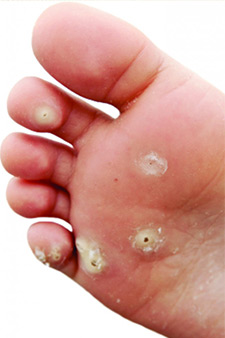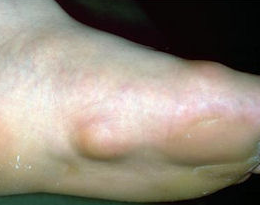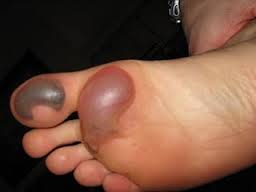A lump or painful bump on bottom of foot can be due to various causes such as infection, trauma or tumor. Some people also have a hard spot on bottom of foot that is painless. These bumps may remain the same size or grow slowly or rapidly. If you have a painful spot on bottom of foot, find out what causes it and what remedies can help reduce your symptoms.
Painful Bumps on Bottom of Foot
Most foot lumps are harmless, but talk to your doctor about a persistent painful bump on bottom of foot. It is important to find out if you have a serious problem or not. Below are the most common causes and treatment for them.
1. Corns and Calluses
 A corn or a callus is the most common cause, which results from constant pressure or friction from your tight shoes. Repeated trauma can also cause a hard spot on bottom of foot. Calluses can be really painful especially if you often stand on your feet all day. These may be associated with some redness and swelling, which usually get better with rest.
A corn or a callus is the most common cause, which results from constant pressure or friction from your tight shoes. Repeated trauma can also cause a hard spot on bottom of foot. Calluses can be really painful especially if you often stand on your feet all day. These may be associated with some redness and swelling, which usually get better with rest.
Treatments: Using moleskin pads can also help relieve pain from a corn. The doctor can recommend using medicated patches, trimming calluses and corns, or correcting them with surgery.
2. Plantar Warts
 A plantar wart is a hard spot on bottom of foot, usually appearing on the heel/ball of the foot, where the most pressure occurs. Excessive pressure also may cause your plantar wart to grow beneath a callus.
A plantar wart is a hard spot on bottom of foot, usually appearing on the heel/ball of the foot, where the most pressure occurs. Excessive pressure also may cause your plantar wart to grow beneath a callus.
Warts are caused by viruses (human papillomavirus or HPV), which enter your body through small breaks,cuts, or weak spots on the skin. They may go away without any treatment. However, if the warts cause a painful bump on bottom of foot and spreads, you can treat them with home remedies or over-the-counter medications. Repeated treatments may be necessary because they tend to recur.
Treatments to remove warts include:
- Peeling them with nonprescription products containing salicylic acid, which are available as liquid or patches. Wash the affected site and soak for about 20 minutes, until you can gently remove dead skin with an emery board or pumice stone. Apply the solution/patch. Liquid solutions are usually applied twice a day. For patches, apply and change every 48 hours. Results may be seen only after several weeks.
- Using cryotherapy. Nonprescription freezing medicines can help remove warts, but FDA cautions that these may be flammable. Do not use them around flame, fire, or other heat sources.
- Covering them with silver duct tape. Cover your hard spot on bottom of foot with duct tape for several days. Soak in water then gently remove dead tissues with a pumice stone/emery board. Leave the wart exposed for 12 hours. Repeat the whole process until your wart falls off.
If these home remedies do not work, talk to your doctor about other treatments such as:
- Stronger solutions of salicylic acid
- Cryotherapy in a doctor's office
3. Plantar Fibromas
 Another possible cause of painful spot on bottom of foot is a plantar fibroma, which is usually found in the arch of the foot, embedded in the band of tissue called plantar fascia. This non-malignant growth can develop in one or both of your feet, and usually persists without treatment. It is not known what causes this condition.
Another possible cause of painful spot on bottom of foot is a plantar fibroma, which is usually found in the arch of the foot, embedded in the band of tissue called plantar fascia. This non-malignant growth can develop in one or both of your feet, and usually persists without treatment. It is not known what causes this condition.
Pain on bottom of foot may be felt when standing or walking barefoot or even when wearing shoes. However, some people do not experience pain.
Treatment options include:
- Steroid injections, which can help shrink the bump and relieve pain.
- Orthotic devices such as shoe inserts, which relieve pain by distributing your weight away from the bump.
- Physical therapy, which includes anti-inflammatory medications.
- Surgical treatment may be considered if the fibroma continues to grow and cause pain. However, recurrence of the fibroma, development of hammertoes and flattening of the foot arch are common complications.
4. Foot Blisters
 Another cause of painful bump on bottom of foot which look like bubbles or bumps are blisters that result from friction. This causes the outer skin layers to rub against each other, separate, then get filled up with fluid. It usually happens when you wear new shoes or poorly fitting shoes.
Another cause of painful bump on bottom of foot which look like bubbles or bumps are blisters that result from friction. This causes the outer skin layers to rub against each other, separate, then get filled up with fluid. It usually happens when you wear new shoes or poorly fitting shoes.
Foot blisters must not be ignored because they can develop bacterial infection, which can lead to impetigo (a localized infection) or cellulitis (a widespread skin infection). Diabetic individuals are more likely to develop foot blisters, which can become seriously infected.
Treatment options include:
- Wearing the right socks to provide extra support for your feet, keep away from moisture, and minimize friction. Avoid using cotton socks, which are more likely to cause foot blisters because of sweat soak up. Instead, use nylon or wicking socks, which permit airing and reduce moisture on the feet.
- Using two pairs of socks to reduce friction.
- Using moleskin bandages and tapes before wearing socks.
- Reducing friction by applying foot creams andpowders.
- Using well-fitted shoes.
If you are an athlete or just trying to exercise and have recurrent blisters that do not improve with these simple measures, consult a specialist who can perform a gait analysis on you. Your blisters may be due to some problem with your anatomical gait, which is causing the excessive friction on your skin.
